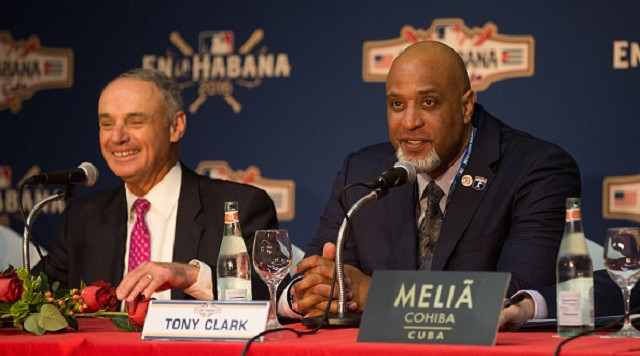Late Wednesday night, MLB owners and players agreed to a new 5-year CBA which ensures business-as-usual for the 2017 season. There were whispers of work stoppage, which would have been typical MLB to ruin momentum gained from a historic World Series, but thankfully the two sides found it within themselves to agree. I think we all owe them our sincerest gratitude.
You can read details of the new agreement here, and be sure to follow Ken Rosenthal on Twitter for how the new qualifying offer system works which appears to be orchestrated by a quantum physicist, but I want to focus on the newly structured luxury tax threshold which should directly affect how the Yankees operate this offseason.
The new agreement states that the tax threshold, which was $189M in 2016, will increase progressively over the next 5 years: 2017 — $195M, 2018 — $197M, 2019 — $206M, 2020 — $209M, 2021 — $210M.
While many fan bases may not care, this has an immediate impact on the Yankees who are no strangers to paying the penalty for overspending. In 2016 their payroll was $227M depending on which site you check, which means they overspent by roughly 20% and paid $19M in taxes. That’s a lot of excess dough, even for the Steinbrenner’s, which is why Hal stated a year ago that the Yankees were looking to get under the luxury tax. The increased threshold coupled with recently shed payroll may allow the Yankees to finally accomplish that goal.
Some of the Yankees’ biggest earners will no longer be on the books in 2017: Mark Teixeira’s $23.1M salary is gone, as is $11.5M of Brian McCann’s. Aroldis Chapman, Andrew Miller, and Carlos Beltran combined to cost the Yankees $22.9M this year, which they swapped for top young talent (props to B-Cash). And let’s not forget about Alex Rodriguez, who won’t cost… ah, never mind.
Per baseball-reference, the Yankees 2017 estimated payroll will be $166.7M, including expected arbitration totals for the 7 players that qualify. For this blog let’s set the following parameters: the 166.7 number will be rounded-up for easy math purposes, the Yankees won’t forego free agency entirely for an unprecedented second straight year, and they will start the season a few mill under $195M to maintain flexibility to add throughout the season if needed. So, how should the Yankees spend the $25M left over?
Assuming the #Yankees can only sign ONE of these in free agency, which should they get?
— The BP Show (@YankeesPodcast) November 30, 2016
Stunning results. A whopping 66% of you would sign a starting pitcher if the Yankees could only make ONE move this offseason. I understand the Yankees rotation is a size 72-point font question mark, but the pool of free agent starters is epically bad.
Rich Hill, the soon-to-be 37-year old blister-having journeyman lefty, is the best pitcher on the market.
Adding Hill to the rotation would only increase the size of the already gigantic question mark. Tanaka had his most durable season as a Yankee in 2016. He made 31 starts and fell (so very ironically) one-third of an inning shy of 200 pitched. CC was perhaps the biggest surprise; he made 30 starts and actually pitched well in the majority of them. Pineda was terrible yet durable. Nathan Eovaldi was terrible yet not durable and is lost for ’17. The remaining rotation spots will be auditioned for by Bryan Mitchell, Chad Green, the Luis boys (Severino and Cessa), and other swing-men type pitchers that spent 2016 in Scranton.
I understand Hill’s numbers were nasty. He posted a 2.12 ERA and 10.5K/9 while slinging a variety of knee-buckling curveballs for Oakland and Los Angeles (keep in mind he only pitched 110.1 innings). Did Hill impress anybody in the playoffs though? His longest start was 6 innings and he got hit pretty hard in the NLDS against Washington. MLB Trade Rumors projects Hill will cost about $16M annually, and they’re usually pretty accurate with their projections.
Having said all that, Hill is the only starter worth paying on the market so if the Yankees sign him, that leaves about $9M to play with. $9M isn’t much, and certainly won’t be enough to sign a reliever like Chapman. It could allow them flexibility to sign Mark Melancon, if he’s feeling generous, or reunite with an old friend like Boone Logan.
If Cashman decides to go the offensive route with the remaining money, we’re looking at a player like Mike Napoli, who may be convinced to sign a 2-year, $18M deal if nobody else shows him interest. Most reports are saying the Yankees are a leading candidate to land Edwin Encarnacion, who will cost $23M annually according to MLBTR. If the Yankees sign a big bat like Edwin, it’s a sign they are abandoning their plans to move under the luxury tax threshold, at least for one more year.




